 |
The Corfield company started just after WWII by two brothers as a small family company, initially in their own home in Wolverhampton! Their first product was an exposure meter for photographic enlargers, the Lumimeter, followed by several other accessories. The success of these and the talent of the Corfield brothers for design and marketing let to the development of their first camera, the 35mm Periflex with Leica screw mount. This compatibility with the Leica was a genius move as it allowed people to use the many accessories that were made for that system and were easily available.
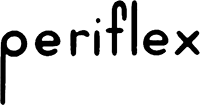
As the name indicated, the original Periflex camera had a unique design feature: a small periscope that could be lowered in-between the focal plane shutter and the lens, and was used to focus the image. Unlike a true SLR, however, the image still needed to be composed using an additional viewfinder. Corfield also produced a 50mm lens, the Lumar, in collaboration with the British Optical Lens Co. As lens and body were made of aluminium, the camera was surprisingly light for its size. The build quality was not quite up to the Leica standard but it was a very capable and successful camera indeed.
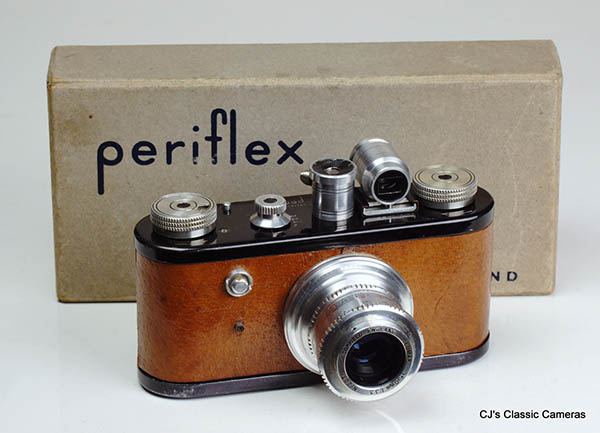
Very first version of the Periflex in black enamel with pigskin cover and Lumar 50mm f/3.5 lens, shown here with its rather plain original box. The pigskin cover stained easily and therefore Corfield soon decided to use black leather instead.
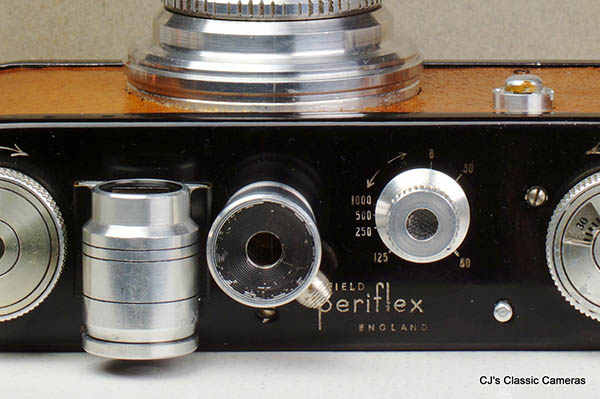
Top view of the pigskin Periflex. There's a few features that characterise this very first version of the Periflex, including a double arrow on the speed dial as well as small markers indicating the speeds. On later production these markers were no longer present, and the double arrow was replaced by a single one.
As said, early production of the Periflex was covered in orange brown pigskin. The story goes that on many early Periflex bodies the original pigskin cover was replaced by black leather, but I don't think this practice was actually all that common. All pigskin Periflex examples I have seen have consecutive serial numbers (from 1971 up to 2401), nearly uninterrupted by black leather ones. Periflex with higher serial# are nearly all covered in black leather, including Periflex with characteristic features of the earliest Periflex production (i.e., two arrows pointing in opposite directions on the speed dial, small markers next to the shutter speed numbers) up to serial# of about 2500. Unfortunately, some eBay sellers actively re-cover black Periflex with pigskin leather, which muddles the picture somewhat, as these aren't always easy to recognise. Nevertheless, it is clear that Corfield started covering their Periflex with black leather before they made changes to the camera bodies.
Another point of contention is how many pigskin Periflex were made. Based on serial#, probably less than 450. Lumar lenses have a similar but unique range of serial#, but they were not matched to the body serial#. A rough correlation exists between lens and body serial#, which may help determining if the lens was original or not.
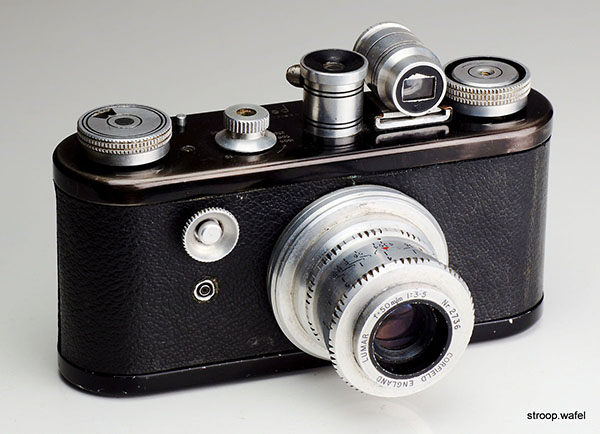
The second version of the black Periflex had black leather instead of pigskin, and is shown here with its matching Lumar 50mm f/3.5 lens. Note the flash sync, which had a small ring around it that was not yet present on the pigskin version (and early production of this version). There were also a few small differences in the shutter speed indicators (see top view below).
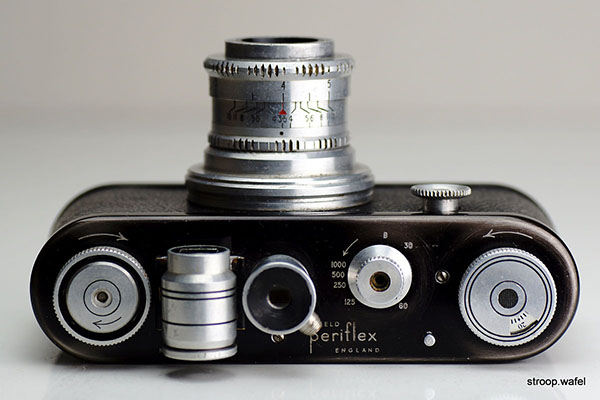
Top view of the black Periflex. By looking down the small eye piece of the periscope finder with the periscope pushed down, one would see an enlarged image of the subject on the focussing screen, allowing the lens to be properly focussed.
Note the single arrow on the shutter speed dial as well as the lack of marks next to the speed indicators, both different from the earliest pigskin Periflex shown earlier.
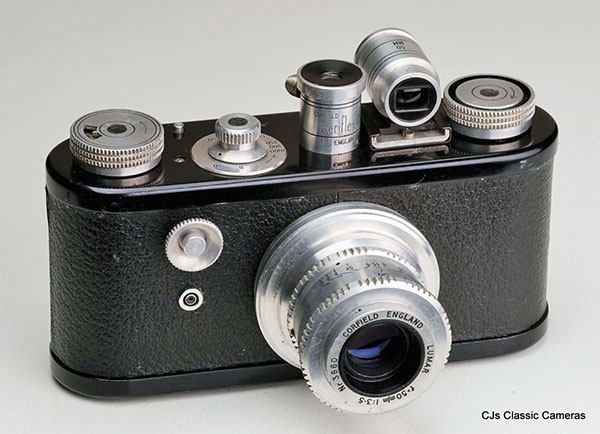
Late production of second version of the Periflex I. This version had an aluminium disk benath the shutter release button, on which the shutter speeds were engraved. It was the same as on the later chrome version of the Periflex I. In addition, the name 'Corfield Periflex England' was engraved on the periscope and no longer on the top housing itself. Again, this was similar to the later chrome model. Also on this model Corfield started to put body# inside the body instead of under the viewfinder. This version is much rarer than the original black leather version of the black Periflex I, and not wel documented anywhere. I thought initally that these were fake painted version of the chrome Periflex I, but the serial# precede those of the chrome ones I have seen, so it appears a genuinely different model, transitional between the original black and later chrome Periflex I. It appears these were still sold with the original Lumar 50mm f/3.5 lens.
The benefit of the periscope focusing aid was that any lens that could be mounted onto the camera could be used and properly focussed. As the Corfield lenses had no rangefinder coupling, the reverse was not true, when using these lenses on other Leica screw mount cameras one will have to rely on the distance markings on the lens.
Camera handling was a little slower than most Leica copies. Winding the camera required two actions: the film was forwarded with the wind knob, then the shutter was cocked separately by turning the shutter speed knob. Similarly, focussing and framing the shot were done separately with the periscope and viewfinder, respectively, which required a change in position of the camera, as one would look down through the periscope, whereas the viewfinder was of course horizontal.
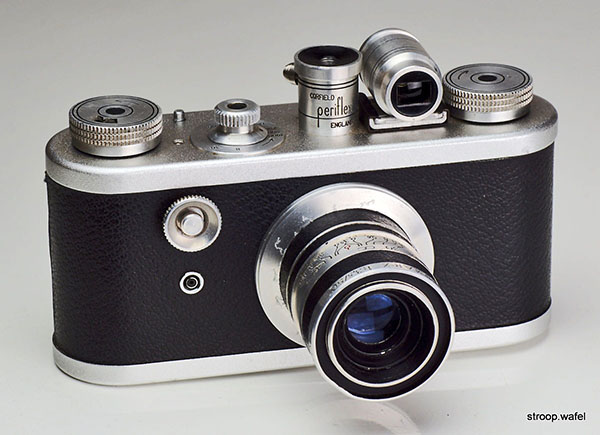
Last variant of the Corfield Periflex I with chrome top and bottom plates. It has the matching Lumar-X lens mounted, which had a redesigned lens barrel compared to the Lumar lens on the earlier black Periflex models.
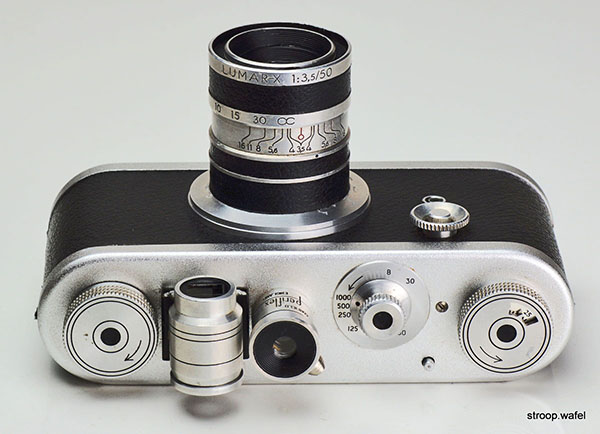
Top view of the chrome coloured version of the first Periflex.
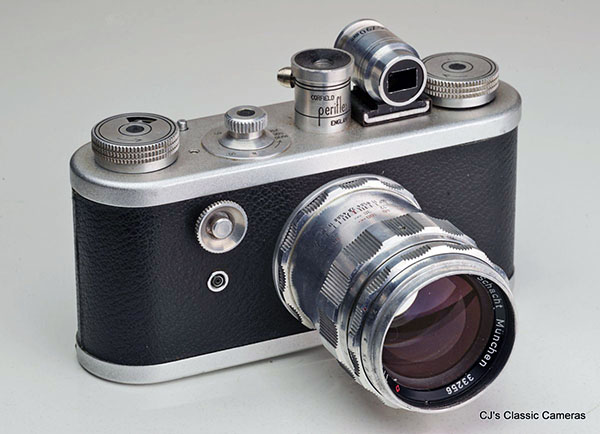
It took Corfield a few years to start producing tele and wide angle lenses to supplement their standard lenses. In fact, in their advertising brochures Corfield recommended the Schacht Travenar 85mm f/2.8 lens (pictured above) for use with their Periflex camera, but did acknowledge this lens was in short supply due to import restrictions. It wasn't until the introduction of the Periflex 3 that Corfield introduced their first non-standard lens: the 100mm f/4 Lumar telelens (see below under Periflex 2). Corfield did produce viewfinders in a range of focal lengths so one could use other Leica-fit lenses if needed.
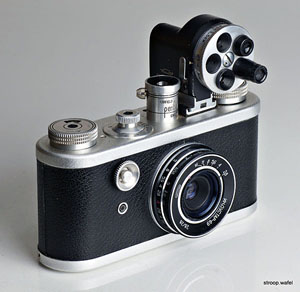
|
One of the fun things about the Periflex was its ability to use, and properly focus, lenses lacking rangefinder coupling, so one could mount many non-native lenses by use of a L39 adapter. A great little lens is the Industar-69 28mm f/2.8 pancake lens. It has a 39mm screw mount but since it was made for the Chaika (a half frame camera with slightly longer register distance than the Leica screw mount), it needs a little work to be made to focus to infinity. In essence, the focussing thread inside the lens needs to be ground down by about a millimetre, but it's well worth the effort although it vignettes quite strongly as it was designed as a half-frame lens.
|
In 1957 the Periflex was nearly completely redesigned and made much more user-friendly. The periscope would automatically lower when the film was advanced and lift again when the shutter was fired. The top housing was enlarged and now contained both the periscope and viewfinder windows. The camera had therefore two eyepieces at the back, so it was much easier to focus and frame the shot than with the Periflex I. In fact, there was a third eyepiece through which one could see the film speed setting, which was adjustable by means of a small dial at the front. It is a little unclear to me what the benefit is of this setup compared to a somewhere on the body of the camera. The viewfinder showed frame lines for two focus distances, infinity and another one marked Fx15 for portrait distance, F being the focal length of the lens mounted to accommodate differences in parallax. The new model had an interesting method of adjusting for different focal lengths. The viewfinder had an interchangeable front element that could be exchanged when necessary for use with different focal lengths. This was a little cumbersome as not only did one have to unscrew one lens and mount another, one had to repeat this procedure for the viewfinder. The shutter speed dial (located beneath the rewind knob) featured an extra set of numbers which indicated the Light Value for a range of different apertures, to aid the use of external light meters. The new Periflex model was called the Periflex 3 and a year later, a less well-featured version, the Periflex 2, was introduced (see below).
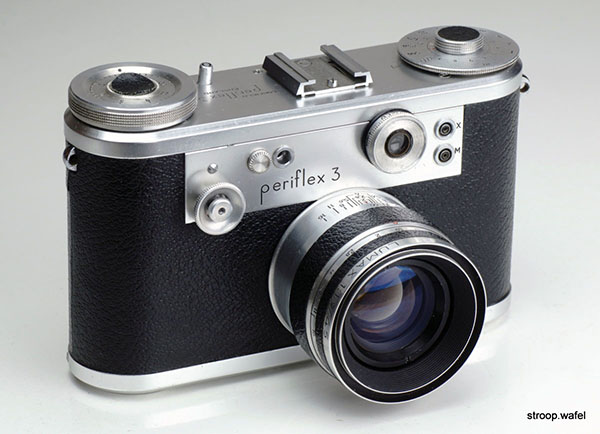
Corfield Periflex 3 with fast Lumax 45mm f/1.9 lens. This six-element lens breached a patent by Wray, which got Corfield into trouble (see more on that below with the Interplan-A). Note the large speed dial on the right side of the camera, which also hosted the rewind knob.
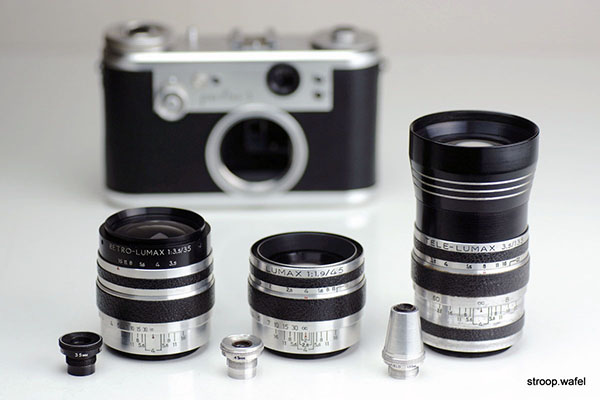
Other lenses introduced roughly around the same time were the wide-angle 35mm f/3.5 Retro-Lumax (on the left) and the 135mm f/3.5 Tele-Lumax (on the right). A slower 100m f/4 was also available. Each lens came with its own dedicated viewfinder that, like the lens, needed to be screwed into the front of the camera.
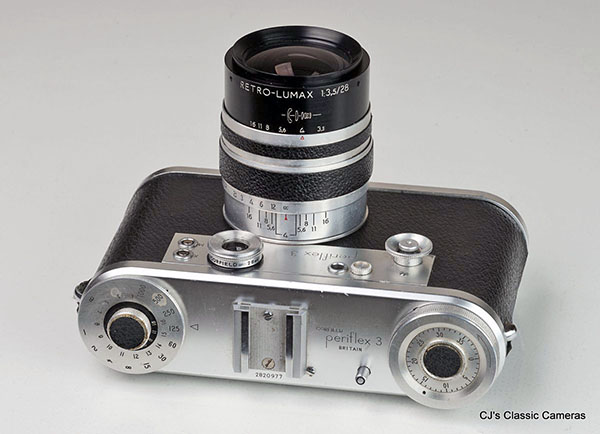
One of my favourite lenses for the Periflex system and one of the rarest: the 28mm f/3.5 Retro-Lumax in its original chrome version. My main reason for liking this lens is a rather geeky one, I suppose: it's mainly to do with the fact that it has its optical formula engraved on the rim. From this we learn that this lens is a six-element lens and identical to the Enna Ultra-Lithagon 28mm f3/5, one of the earliest 28mm lenses available for 35mm cameras. Enna M�nchen undoubtedly made this lens, but unlike most other lenses that Enna made for Corfield (like the later version of the 28mm Retro-Lumax shown on a Periflex 3a below), this one was not simply a rebadged lens; it was actually fitted in a bespoke mount to match the rest of the Corfield line-up. I was also lucky enough to find a matching viewfinder for it.
A year later, a less well-featured version of the Periflex 3 was introduced, the Periflex 2. It had a non-interchangeable viewfinder without any frame lines, a slower top shutter speed of 1/500s, and had no film speed window. It still had an interchangeable lens mount, so one needed to get separate accessory-shoe mounted viewfinders if one wanted to use a lens of a different focal length. Not much of a throwback compared to the system on the Periflex 3 really. The camera was of course cheaper than its more advanced cousin, and the story goes that it was introduced only a year after to avoid eating too much into the sales of the Periflex 3.
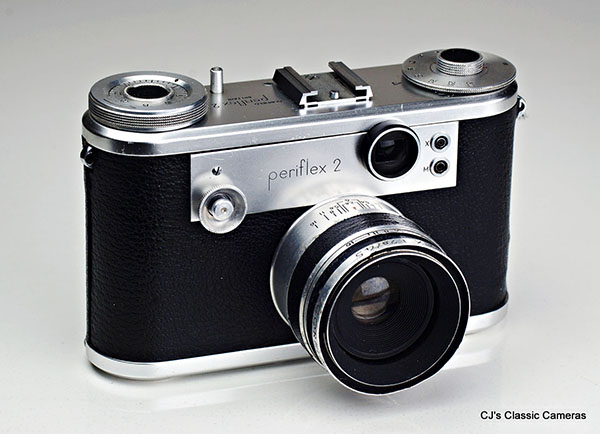
A Corfield Periflex 2 with Lumax 45mm f/2.8 lens.
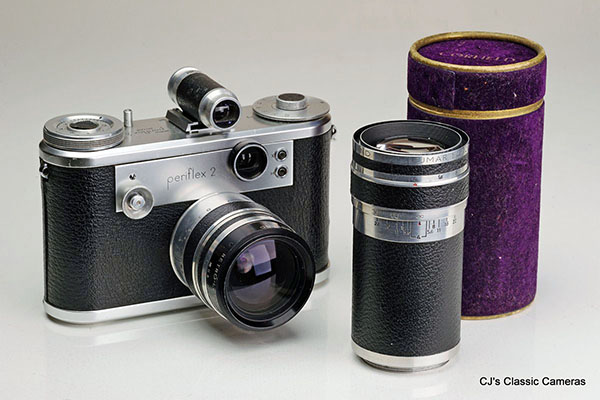
Periflex 2 with 35mm Retro-Lumax lens and its rare matching accessory shoe viewfinder. Unlike the Perfilex 3, which had interchangeable viewfinder lenses, the Periflex 2 had a fixed viewfinder, so needed accessory shoe viewfinders like the earlier Periflex models. Also shown is a 100mm f/4 Lumar telelens and it's original box. It was the first non-standard lens to be made by Periflex, probably introduced during late production of the Periflex I v3, although it only appeared in Corfield brochures with the introduction of the Periflex 3.
In 1959 the Corfield factory moved to Northern Ireland and not long after an updated version of the Periflex 3, the Periflex 3a, was introduced. Most changes were cosmetic and the general layout of the camera remained the same. The main improvements were the introduced of a lever wind instead of a wind knob, and the periscope, which now featured a small split-image rangefinder, which allowed for more accurate focussing. The frame counter (integrated with the wind lever) now also featured a film speed dial, doing away with the extra viewfinder and adjustment dial present on the Periflex 3. The cosmetic changes were most noticeable for the lenses, which were now made in black with grey stripes, in line with the popular 'zebra style' at the time. The wind knobs of the camera where fashioned in a similar style and the interchangeable viewfinder front cells were now made in black.
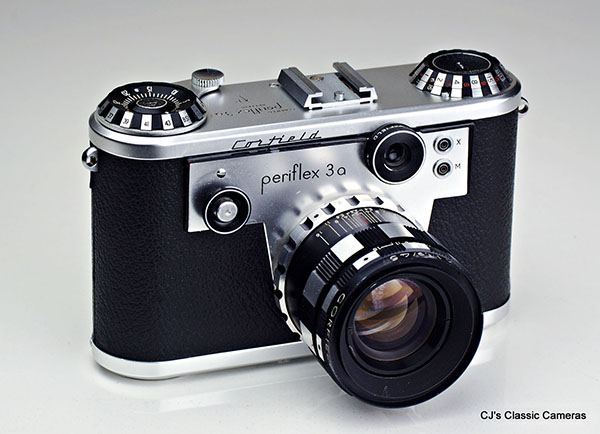
Corfield Periflex 3a with Lumax 45mm f/1.9 lens, an updated version of the same lens as seen on the Periflex 3 above.
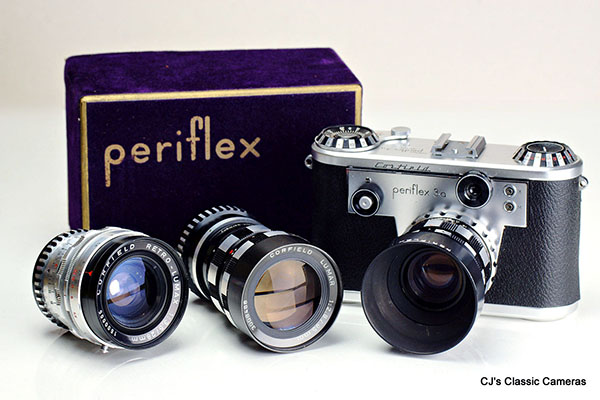
Corfield Periflex 3a with Lumar 95mm f/2.8 telelens and Retro-Lumax 28mm f/3.5 wide-angle lens. The latter is a very rare lens and in fact identical to the six-element Enna Ultra-Lithagon 28mm which was available in m42 and Exakta mounts. Corfield probably ordered these specialty lenses in small batches based on demand; they were easy to adapt to the m39 mount by Enna by simply adding an m39 flange, as no rangefinder coupling was needed with the Periflex system. Another example was the 85mm f/1.5 Super-Lumax, which was equivalent to the Enna Ennaston (later Lithagon) 85mm f/1.5. I've only seen a few of the Retro-Lumax 28mm, they all have serial# close to 1,500,000 (the one shown here has 1,500,005) suggesting very limited numbers. It was also available in the original polished alloy mount, which is equally rare or even rarer. Although apparently 28mm viewfinders were also available I have never seen one.
The three-element 95mm Lumar also has an Enna equivalent (Ennalyt 95/2.8) and is a little more common than the 28mm Retro-Lumax. It replaced the slower 100mm f/4 lens.
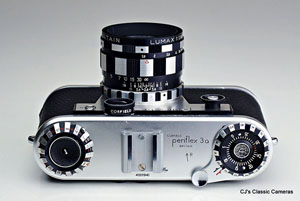
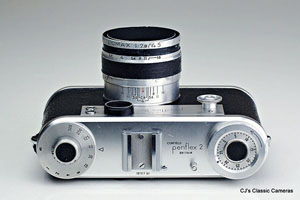 |
Comparison of top plates of the Periflex 2 and Periflex 3a.
A few years after the introduction of the Periflex 3a, in 1961, the Periflex 2 was also updated. This version was called the Gold Star, not 2a as one might have expected. Perhaps this was because the Gold Star was better featured than the Periflex 2 and in fact very similar to the Periflex 3a, the main difference being only its lack of the fastest shutter speeds. The Gold Star was a very successful model and probably the Periflex that is most easy to get nowadays.
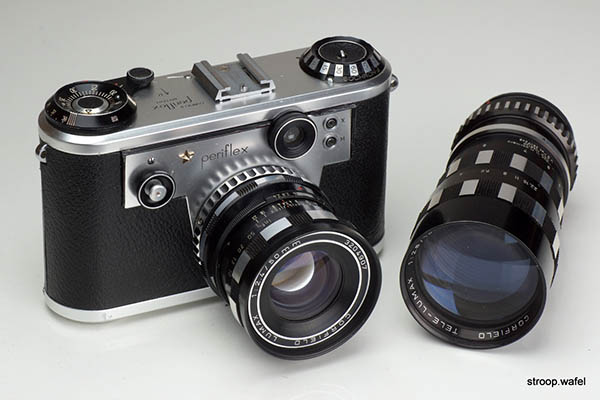
Corfield Periflex Gold Star with Lumax 50mm f/2.4 lens, the standard lens for this model. Introduced around the same time was the 135mm f/2.8 Tele-Lumar lens, the fast aperture belying its comparatively small size. The patent associated with this five-element telephoto lens, which was made by Enna-Werk in Munich, Germany, can be found here.
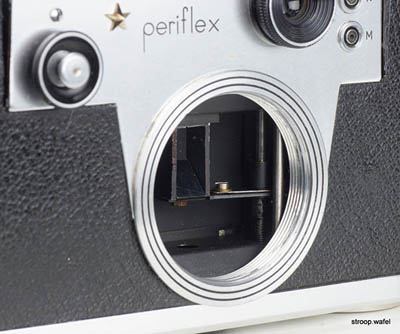
| |
Close-up of the periscope lowered into the body. Upon pushing the shutter release, the periscope would shoot upwards out of the way and would then trigger the focal plane shutter.
|
One particular benefit of the periscope finder was that it was very convenient for macro photography. Whereas rangefinders needed accessories like additional close-up rangefinders (like the Kodak Retina) or proximeters, on the Periflex one could just add an extension tube of appropriate length and shoot. Framing the shot was perhaps a little more difficult, as the periscope would only show the centre portion of the frame, but based on the magnification factor one could work out the approximate view in close-up shots
If more accuracy was needed an extra accessory was available, the focusing screen adapter. One would mount this adapter on the lens, with the latter secured by a clamp and a tripod, and the ground glass would show the exact focus and frame size. Afterwards one would replace the adapter with the camera body. This accessory is also very handy for testing Leica screw mount lenses.
Corfield went on to make several more versions of the Periflex called the Interplan, including versions for LTM (Interplan-A), m42 (Interplan-B) and Exakta (Interplan-C) lens mounts. The latter two simply had fixed LTM adapters mounted on the body. The Interplan lacked the periscope viewfinder, but the name Periflex was still used on the cameras nonetheless. They had a fastest shutter speed of 1/300 compared to 1/1000 on the Periflex 3a.
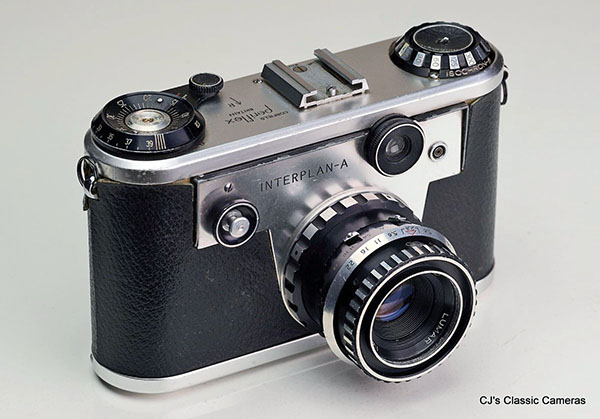
Corfield Periflex Interplan-A with Lumar 50mm f/2.8 preset lens. This rather rare front-cell focussing lens had two aperture indicators that looked a little like depth of field indicators, but were in fact an aperture setting lever and aperture stop, respectively. Thus, one could focus with the aperture fully open and then move the aperture lever to its correct exposure setting without needing to take one's eye of the viewfinder. This was a useful feature to have, but ironically, it was pointless on the Interplan-A as it does not have through-the-lens focussing. Nevertheless, it appears to be the lens most commonly found on this model.
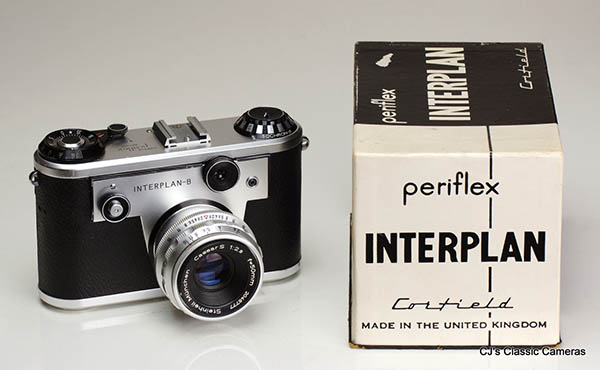
Corfield Periflex Interplan-B with Steinheil Cassar 50mm f/2.8 lens, shown with its original box. The camera also came with a manual, which was essentially a leaflet stapled around a Periflex IIIa manual with a warning that the periscope focussing did not apply (!).
This camera had a M42 mount (also known as Praktica or Pentax mount). There were a few Corfield branded lens available for it (made by Enna Munchen) but that sort of defeats the point, I suppose one would buy this camera if one already had some M42 lenses. To be honest, I sort of miss the point of this camera; if one wanted to use M42 lenses one could simply use an M42-LTM adapter on an Interplan-A. But I suppose that if you knew you were going to use M42 lenses only, a fixed mount would be the more reliable choice.
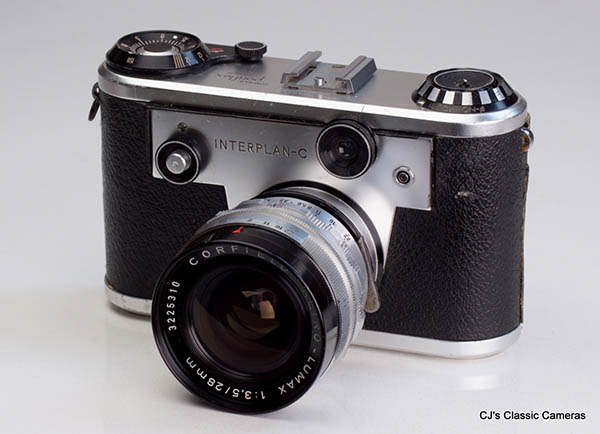
Corfield Periflex Interplan-C with Corfield Retro-Lumax 28mm f/3.5 lens (made by Enna Munchen) in Exakta mount. Other than the mount, the Retro-Lumax is the same as the one shown above with the Periflex 3a. However, the serial# fall in different ranges. Rather curiously, the focal length of the viewfinder mounted on this example is indicated as '58 mm', an unusual number that I have not seen on any other Periflex before. Clearly, this example was meant to be used with the Carl Zeiss Biotar 58mm f/2, a popular lens for the Exakta Varex (I have one here). Note that a 28mm viewfindr does exist, I recently obtained a chrome-coloured version.
The Periflex 3b was the last Periflex model. It was a modest update of the Periflex 3a, the main functional difference being the addition of an extra flash contact, although it is unclear to me what type of flash it was for. The most obvious difference was cosmetic, the Periflex 3b was fashioned in black, just like the original Periflex. Clearly, fashion comes in cycles.
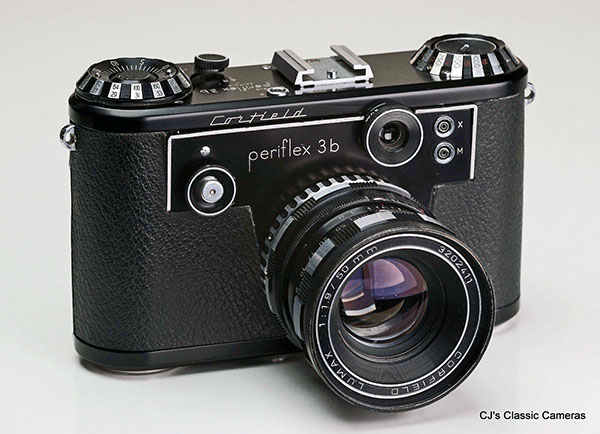
Corfield Periflex 3b with Lumax 50 mm f/1.9 lens, an updated version of the lens on the Periflex 3 above and the standard lens to come with this model. It was introduced around the same time as the Lumax 50mm f/2.4 lens on the Goldstar above. The lenses looked very similar, in fact the bodies appear identical. They were both made in Germany by Enna-Werk, but the f1/.9 lens had the marking 'Lic'd by Wray'. It also shows patent nr. 575076 which can be found here. It was a 1944 patent for a five-element version of the double Gauss lenses such as the Zeiss Biotar and Schneider Xenon by removing the rear element and separating and bending the rear doublet. It appears that the earlier version of the f/1.9 Lumax infringed the patent by Wray, even though it was a six-element lens, after which Corfield were forced to add the patent info to the lens and presumably pay Wray a licensing fee.
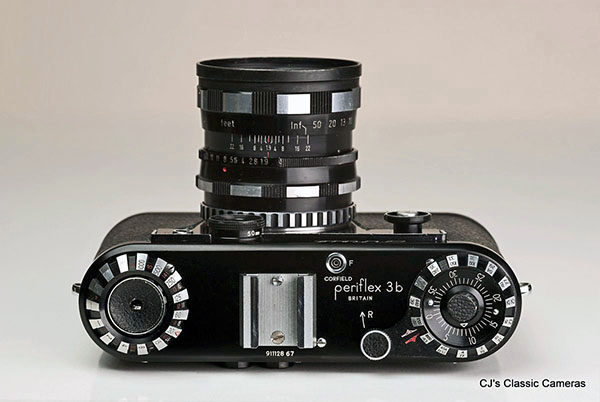
Top view of the Corfield Periflex 3b. The main difference with the Periflex 3a (other than the colour) was the addition of an flash sync socket on the top, bringing the total to no less than three.
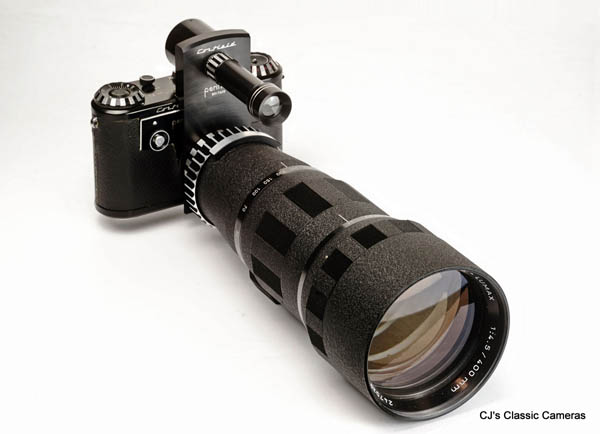
If you think big lenses are a recent invention, think again. Here's a Periflex 3b with a massive Tele-Lumax 400mm f/4.5, and that's without it screw-on lens hood. This lens and it's smaller 240mm sibling had dedicated telescopic viewfinders, as the regular interchangeable viewfinders were blocked by the size of the lens. These viewfinders were mounted on a flange which screwed onto the camera's lens mount. To accomodate the extra thickness, the actual lens had a longer register distance than a regular 39mm Leica screw mount, something to be aware of when buying one without the viewfinder flange (as they are often advertised, but this detail is seldom mentioned, even by sellers that should know better). To aid mounting the lens had a rotating collar which could be secured once the lens was mounted. The lens even had a slip in filter holder behind the rear element, just like many modern telelenses. It was branded Corfield but was in fact made by Enna Munchen, just like most of the rest of the Corfield lens range.
Like many camera companies, Corfield also produced cameras adapted for use with technical equipment such as microscopes. They also made a microscope adapter. Often technical cameras had no viewfinders as this would only work if the image would be taking through the lens, not a separate viewfinder. Besides, the optical system mounted to the camera was designed so that no adjustment was needed or even desired.
Both main Periflex body types (original Periflex I and later models) were available as technical cameras. There was also a lens marketed as 'Technical 50mm' which had no aperture control, and thus similar to a enlarger lens.
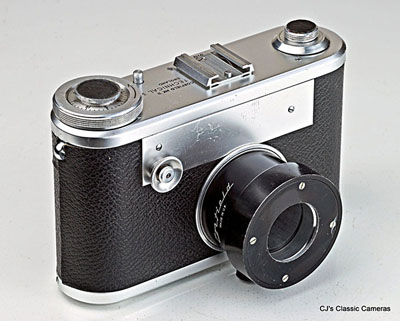
|
Corfield Technical 35 with attached microscope adapter. The body type is that of the Periflex 2 and 3, but without viewfinder, periscope, or flash sync, hence the blank front plate. This one is marked Mk II and only has a B setting as shutter speed, which makes me wonder what it was used for. I have also seen a Mk IV which had a range of speeds of 1 s to 1/30 s.
|
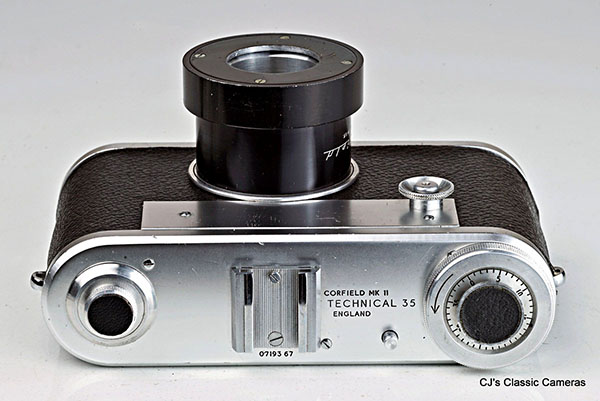
Top view of the Corfield Technical 35. Note this example is marked as 'England', typical of early Periflex 3 models from before Corfield moved to Northern Ireland and the markings changed to 'Britain'.
The company's final camera, the Corfield 66, was introduced in 1961 and was quite a change from what it had done before, a medium format SLR camera not dissimilar to the Hasselblad 500C and Fujita 66 also around at the time. It was a well-constructed camera without any fancy features, presumably in an attempt to keep the price down (e.g., the fold-up leather viewing hood), but it put the money where it was needed. It had an instant return mirror and was flash synchronised although the synchronisation speed was a slowish 1/15s. However, in the early 60s electronic flashes were available that had very short flash times of <1/500s, so the slow synchronisation speed wasn't a real problem. A ring around the focus knob set the flash delay time for various flash types, it is not a manual frame counter as I first thought!
Unfortunately the Corfield 66 is where the story ended; increased competition in the 1960s from Japan led to camera production no longer being profitable although some unfortunate business decisions, including the move to Northern Ireland and a sell-out to Guinness (!), had also taken their toll.
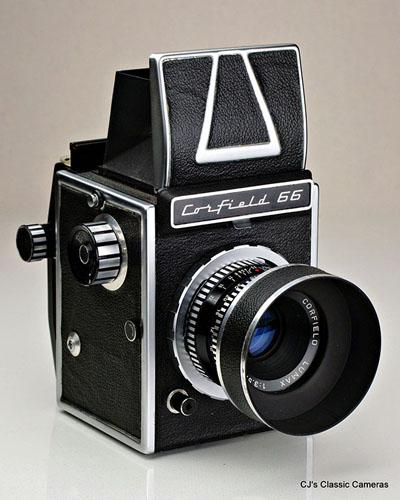
| |
A Corfield 66 with its standard four-element Lumax 95mm f/3.5 lens and dedicated lens hood. This example was in a rather poor state when I got it, with the leather peeling everywhere, shutter very sluggish, lens focus frozen and aperture ring loose, and all light seals perished and spreading disintegrated bits of foam everywhere. The peeling leather is very common on this model, it was attached with double-sided glued paper, which has lost its stickiness over time. Thankfully, due to its construction the camera was fairly straightforward to service and is ready for action once again.
|
|
The Corfield 66 could be used with an interchangeable 120 film back (shown here) or with plates for single 6x6 film sheets. Note the fold-up viewing hood of the waist-level viewfinder, made from leather instead of the more usual metal plates. A simple construction, but on this example it does not stay open very well, making framing the shot accurately difficult.
| |
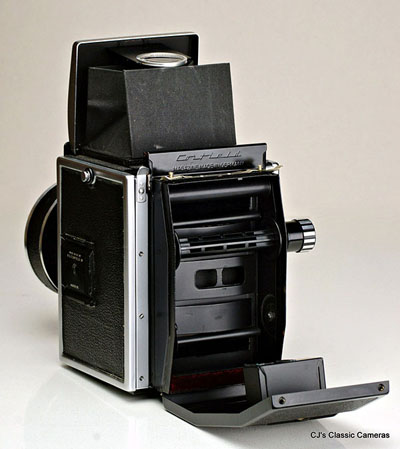
|
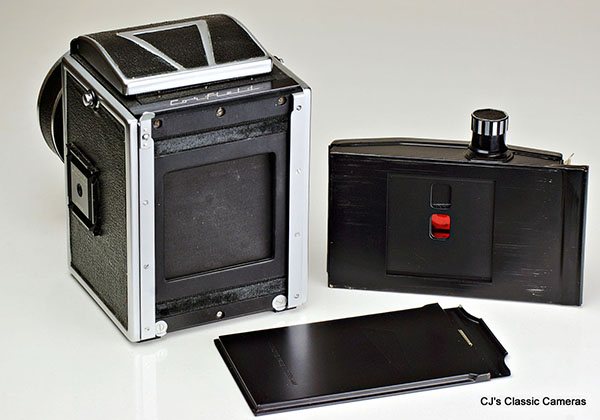
Corfield 66 with the interchangeable back removed, exposing the large focal plane cloth shutter. A blank slide needed to be inserted into the film back to avoid accidental exposure of the film. The film sheet plates produced slightly larger negatives of nearly 60x60mm than the standard 120 roll film size of 56x56mm.
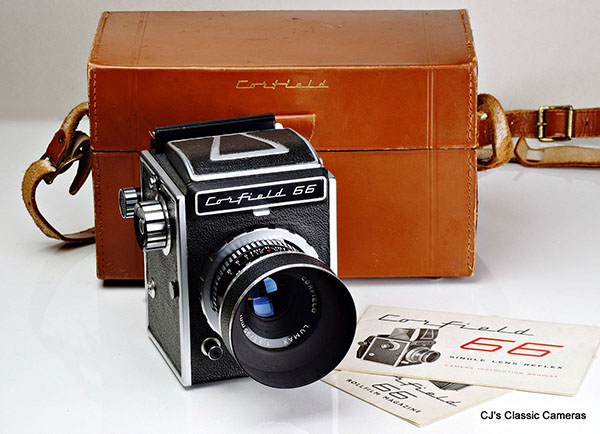
The Corfield 66 came with a large leather case that could also hold a spare film back or a set of single exposure plates. Carrying all this around must have been hard work!
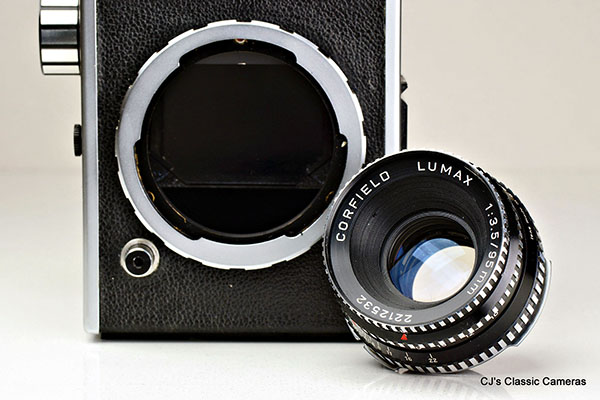
To finish, a detail of the Corfield 66 lens mount, which was essentially a breech lock mount, the lens being secured to the camera body by a rotating ring. Like most of Corfield's lenses, the Lumax was made by Enna Werk in Germany. Even though the lens was interchangeable, no other lenses were made for this mount, which is unfortunate, the wide 57mm throat would have been ideal for e.g., a fast portrait lens.
Corfield started out as a company by making photographic accessories before they moved into producing cameras. Their first product was an enlarger exposure meter, the Lumimeter, followed by a handheld rangefinder, the Telemeter and an extinction exposure meter. They were well-built and well-finished products, even though they may be perceived cumbersome today. The success of the accessories and the profits that came with it gave Corfield the confidence to branch out into the camera business itself.
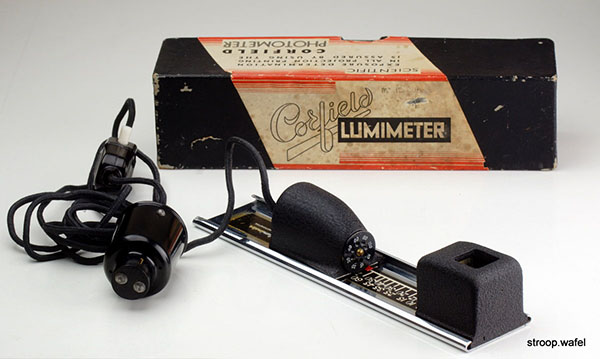
The first Corfield product: the Lumimeter, which went for sale in 1948 and was assembled in the attic of the Corfield family home.
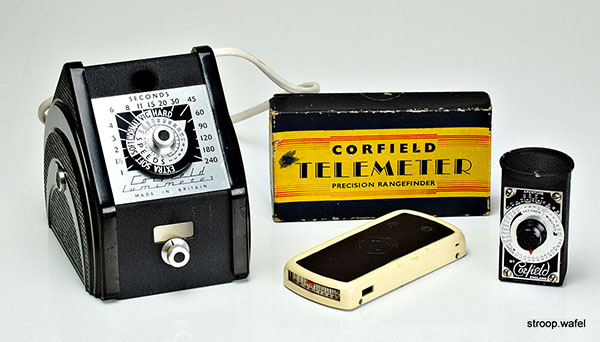
Corfield Lumimeter II, Telemeter (with its box) and Optical Exposure meter.
|

